L'ospite sconosciuta (1923)
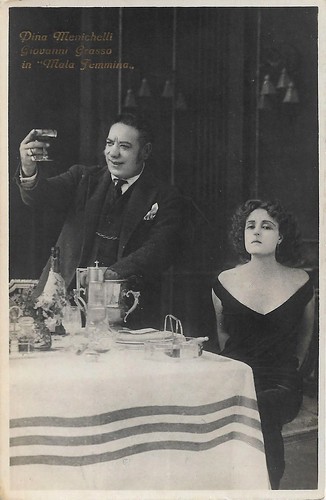
Italian postcard by G.B. Falci, Milano. Photo: Fotominio. Pina Menichelli and Giovanni Grasso in Malafemmina, a title unknown to IMDb, but it is the alternative title of L' ospite sconosciuta/The Unknown Guest (Telemaco Ruggeri, 1923).

Italian postcard by G.B. Falci, Milano, no. 182. Pina Menichelli and Andrea Conigliaro in Malafemmina a.k.a. L'ospite sconosciuta/The Unknown Guest (Telemaco Ruggeri, 1923).
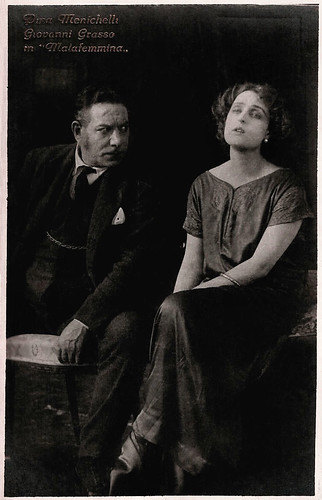
Italian postcard by G.B. Falci, Milano, no. 189. Pina Menichelli and Giovanni Grasso in Malafemmina a.k.a. L'ospite sconosciuta/The Unknown Guest (Telemaco Ruggeri, 1923).
L' ospite sconosciuta/The Unknown Guest (Telemaco Ruggeri, 1923) was written by future director Amleto Palermi. Pietro, a young provincial (Andrea Conigliaro) falls into the clutches of Stasia, a mundane adventuress (Menichelli), and spends his father's money on her. Di Scenta, the father (Giovanni Grasso), pushes the woman to convince the son she never loved him and enforces this by having his son discover the two of them in a restaurant. The son shoots the woman, while the father takes the blame.
The Italian censorship was so heavy in its cuts that the film became incomprehensible to Italian audiences. Italian critics didn't like it, therefore. The censor didn't allow the representation nor even the suggestion that the son thinks he has to compete with his father in his love for Stasia. So all the scenes in which the father pretends his love for the woman in order to save his son were cut, as well as intertitles explaining this situation.
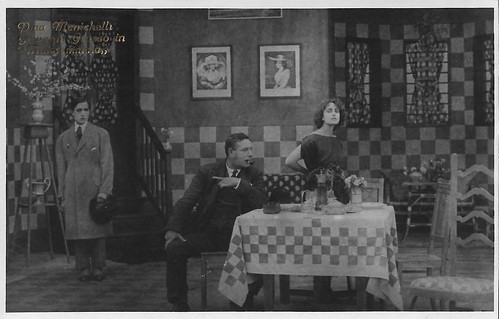
Italian postcard by G.B. Falci, Milano, no. 241. Pina Menichelli and Giovanni Grasso in Malafemmina a.k.a. L' ospite sconosciuta/The Unknown Guest (Telemaco Ruggeri, 1923).
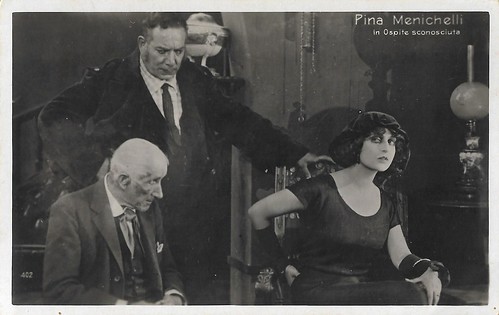
Italian postcard by Vettori, Bologna, no. 402. Pina Menichelli and Giovanni Grasso in L' ospite sconosciuta/The Unknown Guest (Telemaco Ruggeri, 1923).
La dama de Chez Maxim (1923)

Italian postcard by G.B. Falci, Milano, no. 253. Pina Menichelli and Marcel Lévesque in La dama de Chez Maxim/La dame de Chez Maxim's (Amleto Palermi, 1923). Menichelli played the legendary Môme Crevette in one of the many film adaptations of Georges Feydeau's classic boulevard comedy.
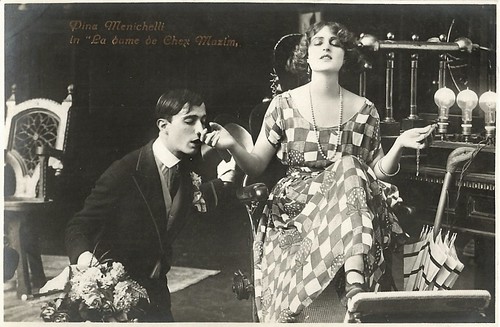
Italian postcard by G.B. Falci, Milano. Pina Menichelli in La dama de Chez Maxim's (Amleto Palermi, 1923). The man may be Alfredo Menichelli, Menichelli's younger brother, who plays the young duke.

Italian postcard by Ed. G.B. Falci, Milano, no. 206. Pina Menichelli and Marcel Lévesque (right) in La dama de Chez Maxim/La Dame de Chez Maxim's (Amleto Palermi 1923).
With La dama de Chez Maxim/La dame de Chez Maxim's (Amleto Palermi, 1923) and with Occupati d'Amelia (Telemaco Ruggeri, 1925), another Georges Feydeau adaptation, Menichelli proved she was well able to do comedy and not only melodramatic and 'vampy' films. In both films, one of her co-stars was the French comedian Marcel Lévesque. The films were well received.
From 1920 Menichelli, after her years at Itala, moved to Rinascimento Film, founded in 1918 and run by producer Baron Carlo D'Amato, with whom she would have a long relationship before marrying him in 1930. Rinascimento Film produced several films with Menichelli in the early 1920s including Il romanzo di un giovane povero, La seconda moglie, Malafemmina, La donna e l'uomo, and La dama de Chez Maxim. In 1924 Menichelli withdrew from cinema and held back any attempt to interview her.
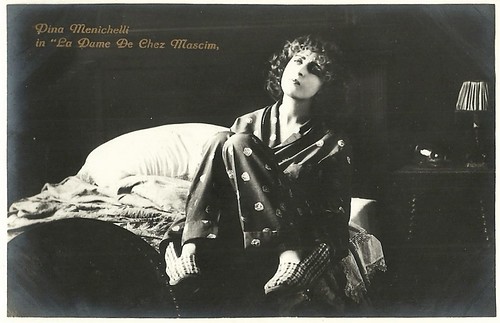
Italian postcard by G.B. Falci, Milano. Pina Menichelli in La dama de Chez Maxim (Amleto Palermi, 1923).
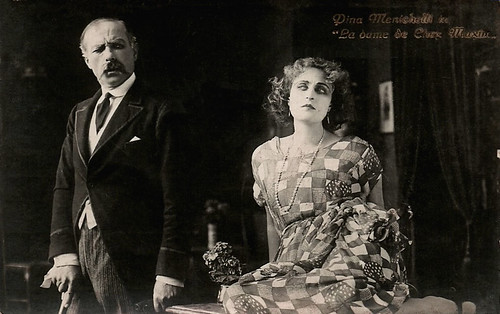
Italian postcard by G.B. Falci, Milano, no. 82. Photo: La Fotominio. Pina Menichelli in La dama de Chez Maxim (Amleto Palermi 1923). Here also with Ugo Gracci as Petypon.
La donna e l'uomo (1923)
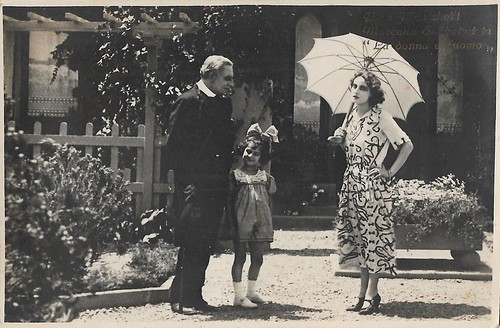
Italian postcard by G.B. Falci, Milano, no. 118. Photo: La Fotominio. Pina Menichelli and Marcella Sabbatini in the drama La donna e l'uomo (Amleto Palermi, 1923). The film was produced by Rinascimento Film and distributed by UCI.

Italian postcard by G.B. Falci, Milano, no. 180. Photo: Fotominio. Pina Menichelli and Alfredo Bertone in La donna e l'uomo (Amleto Palermi, 1923). The film was produced by Rinascimento Film and distributed by UCI.

Italian postcard by Ed. G.B. Falci, Milano. Postcard for the 1923 Italian silent film La donna e l'uomo, directed by Amleto Palermi, produced by Rinascimento Film and distributed by UCI. The Star of the film was the Italian diva Pina Menichelli, but the card shows Milton Rosmer and Marcella Sabbatini. The woman is unknown.

Italian postcard by G.B. Falci, Milano, no. 223. Pina Menichelli and Milton Rosmer in La donna e l'uomo (Amleto Palermi, 1923).
In La donna e l'uomo/Woman and man (Amleto Palermi, 1923), young Gilian (Menichelli) has married the egoist and unworthy Philip O'Mara (Milton Rosmer), who after having reduced her to misery, abandons her and her daughter, little Dora (Marcella Sabbatini), and leaves for Australia. When the woman meets a rich baron who offers help and asks her to marry him (Livio Pavanelli), Philip returns and starts to persecute his wife with letters, asking for money. While Gillian is vexed and on the verge of paying him, he is killed by a guy whom he had cheated on. Liberated from her nightmare Gilian can start a new life.
The film La donna e l'uomo was partly shot in the UK. The British actor and director Milton Rosmer (1881-1971) got in exchange for his contribution a distribution contract by UCI for his own film The Diamond Necklace (1921). Instead of her usual femme fatale parts, Pina Menichelli here played a tormented, simple woman, brutally treated by her husband. She was praised in the Italian and British press for her emotional, sincere performance. La rivista cinematografica indicated the film as 'naked realism', though treated with poetry. While several films with Menichelli are still lost, this film was found and restored by Les Archives du Film du C.N.C.
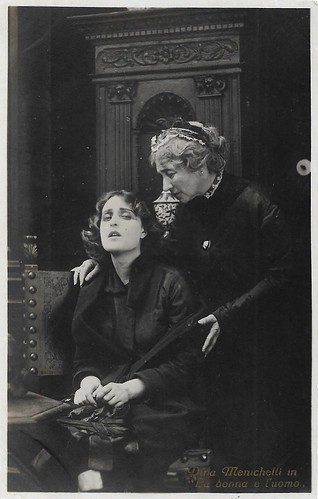
Italian postcard by G.B. Falci, Milano. Photo: Fotominio. Pina Menichelli in La donna e l'uomo (Amleto Palermi, 1923).
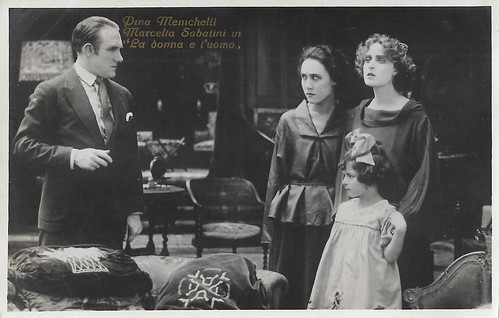
Italian postcard by G.B. Falci, Milano. Photo: Fotominio. Pina Menichelli, Milton Rosmer and Marcella Sabbatini in La donna e l'uomo (Amleto Palermi, 1923).
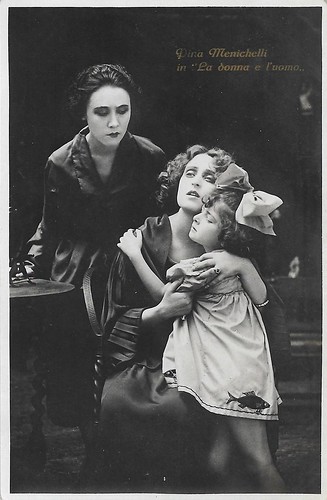
Italian postcard by G.B. Falci, Milano. Photo: Fotominio. Pina Menichelli and Marcella Sabbatini in La donna e l'uomo (Amleto Palermi, 1923).
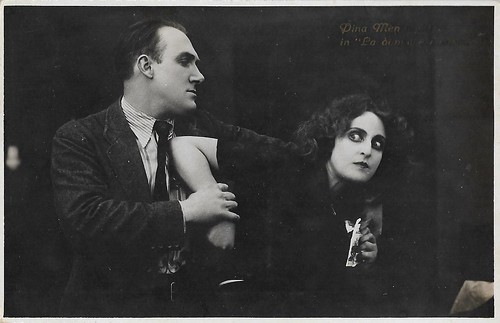
Italian postcard by Ed. G.B. Falci, Milano. Pina Menichelli and Milton Rosmer in La donna e l'uomo (Amleto Palermi, 1923), produced by Rinascimento Film and distributed by UCI.
Sources: Vittorio Martinelli (Il cinema muto italiano, 1923-1931), and IMDb.
This post was last updated on 18 December 2022.
No comments:
Post a Comment